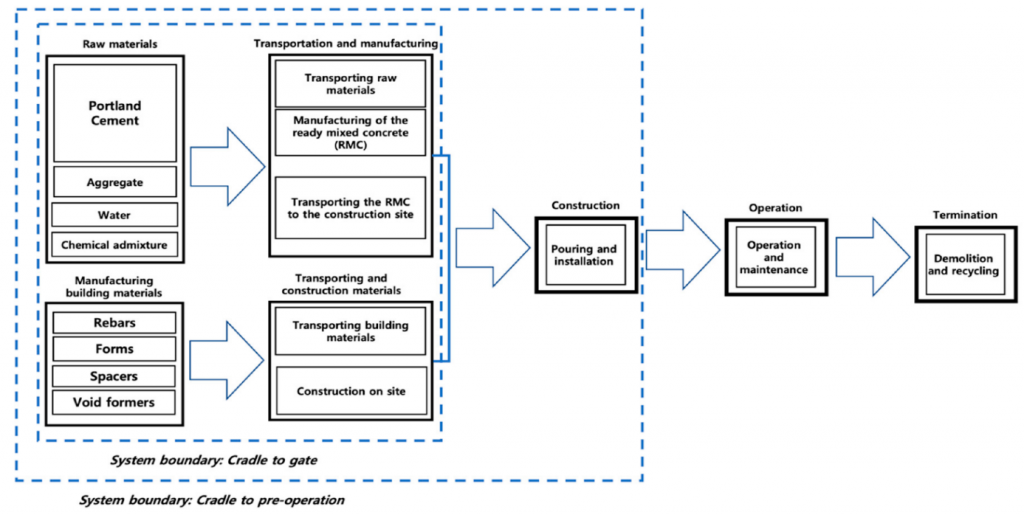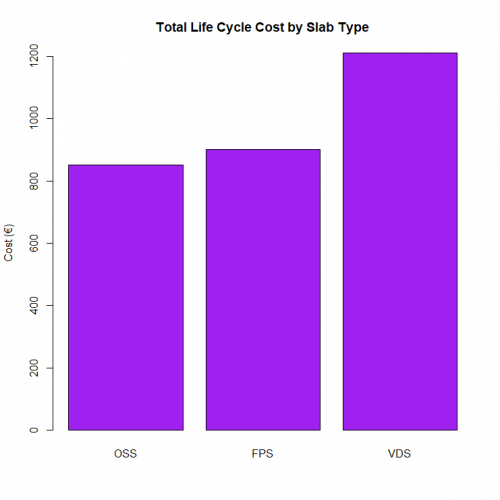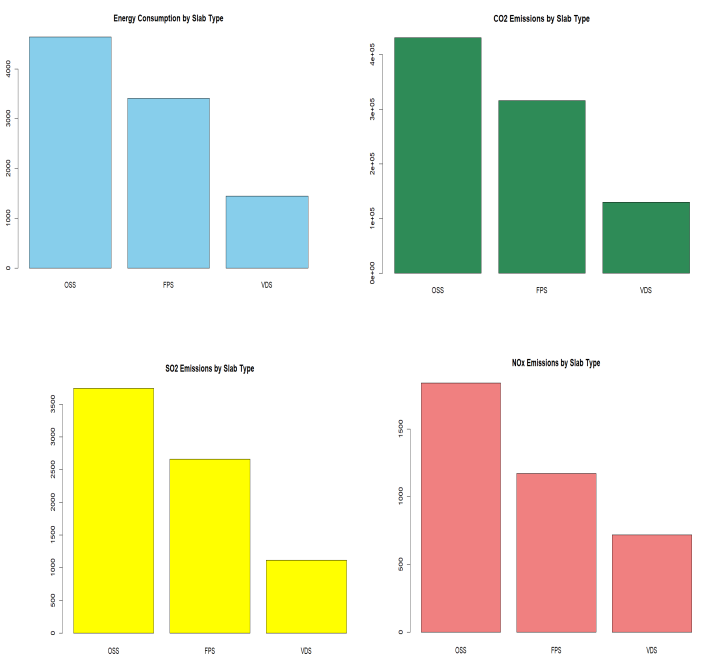By Krishna Giri / 0508046
Life Cycle Assessment & Multi-Criteria Decision Making: RCC Slab Systems
Summary
The construction industry is a significant contributor to global energy consumption and greenhouse gas (GHG) emissions, making sustainable material selection a key priority. This study conducts a Life Cycle Assessment (LCA) to evaluate the environmental impact of three reinforced concrete (RCC) slab systems: Ordinary Solid Slab (OSS), Flat Plate Slab (FPS), and Voided Deck Slab (VDS), during the construction phase. The analysis focuses on energy use, CO₂, NOx, and SO₂ emissions, along with life-cycle costs (LCC), to identify the most sustainable and cost-effective slab alternative.
Figure 3: System Boundary for the construction process
Design Options
| Design Options | Slab Type | Cross-Section | Depth (m) | Scope |
|---|---|---|---|---|
| 1 | OSS (Ordinary Solid Slab) | L = 5 m, B = 5 m | 0.25 | Conventional, uses more concrete. |
| 2 | FPS (Flat Plate Slab) | L = 5 m, B = 5 m | 0.20 | Requires the highest reinforcement. |
| 3 | VDS (Voided Deck Slab) | L = 5 m, B = 5 m | 0.15 | Lightweight, uses voided materials. |
Fig 4: Schematics of the Slab System in a Building
Life Cycle Inventory Analysis
| Material | Scope | Quantities(kg/m3) | Energy (MJ/t) | CO2 (kg) | NOX (kg) | SO2 (kg) |
| Cement |
OSS |
382.4 | 3.26 | 0.822 | 0.177 | 0.065 |
| Coarse Aggregate | OSS | 1057 | 0.0035 | 0.016 | 0.0018 | 0.0018 |
| Fine Aggregate | OSS | 837 | 0.0023 | 0.0053 | 0.009 | 0.009 |
| Reinforcement Steel | OSS | 305 | 2430 | 225 | 0.71 | 1.85 |
| Forms | OSS | 50 | 0.5 | 0.02 | 0.01 | 0.005 |
| Cement | FPS | 234.8 | 3.26 | 0.822 | 0.177 | 0.065 |
| Coarse Aggregate | FPS | 946 | 0.0035 | 0.016 | 0.0018 | 0.0018 |
| Fine Aggregate | FPS | 555 | 0.0023 | 0.0053 | 0.0009 | 0.0009 |
| Reinforcement Steel | FPS | 350 | 2430 | 225 | 0.71 | 1.85 |
| Forms | FPS | 50 | 0.5 | 0.02 | 0.01 | 0.005 |
| Cement | VDS | 187.7 | 3.26 | 0.822 | 0.177 | 0.065 |
| Coarse Aggregate | VDS | 805 | 0.0035 | 0.016 | 0.0018 | 0.0018 |
| Fine Aggregate | VDS | 512 | 0.0023 | 0.0053 | 0.009 | 0.009 |
| Reinforcement Steel | VDS | 215 | 2430 | 225 | 0.71 | 1.85 |
| Forms | VDS | 50 | 0.5 | 0.02 | 0.01 | 0.005 |
| Steel Decking | VDS | 40 | 2430 | 225 | 0.71 | 1.85 |
| Void Fillers | VDS | 128 | 169.69 | 3.09 | 0.766 | 0.036 |
Table : Lifecycle Inventory Materials for RCC Slab Construction
Cement production is the main contributor to CO₂ emissions, while reinforcement steel has high energy demands. VDS reduces concrete use with void fillers, lowering emissions, while SO₂ and NOx mainly come from transport and equipment.
Emission and energy data were sourced from industry-standard databases and adjusted for Pokhara, Nepal, to reflect local construction practices and material availability.
Life-Cycle Cost Analysis
Fig: Visualization of total life-cycle costs of different slab types
OSS is the cheapest option due to low material and maintenance costs while VDS is the most expensive because of costly materials, complex production, and higher maintenance needs.
Results and Discussions
1. Life Cycle Assessment
Fig 7: Bar plots showing the Energy Consumption and Emissions for different Slab Options
- OSS consumes the most energy (4640.170 MJ) due to its high material use, while VDS uses the least (1444.525 MJ) because of its lightweight design.
- OSS has the highest emissions (CO₂: 431,000 kg, SO₂: 3742.448 kg, NOx: 1838.565 kg) due to its high cement and steel content.
- FPS has moderate energy use and emissions, balancing material efficiency with structural strength.
- VDS has the lowest emissions as it uses less concrete and steel, making it the most environmentally friendly option.
2. Multi-Criteria Decision-Making Analysis- AHP
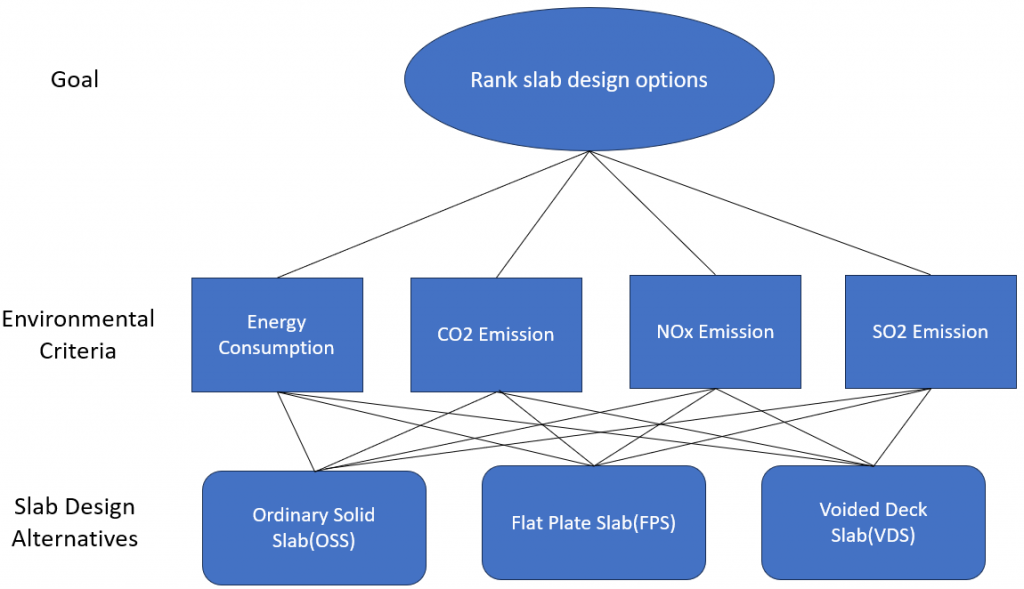
Fig: Generic Hierarchic Structure
The Analytic Hierarchy Process (AHP) was employed to rank three slab design options: OSS, FPS, and VDS, based on four criteria: energy consumption, CO2, NOx, and SO2 emissions.
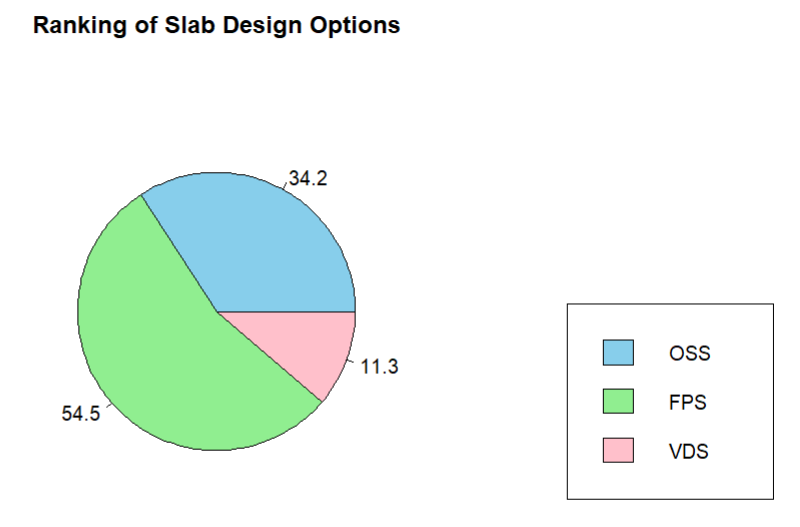
Fig: Ranking of the slab design options using AHP
- FPS ranked highest (54.5%) in AHP due to its balanced structural, economic, and environmental performance.
- OSS ranked second (34.2%), being cost-effective but environmentally harmful.
- VDS ranked lowest (11.3%), despite its sustainability advantages, due to higher costs and maintenance challenges.
Conclusion and Recommendations
The study highlights trade-offs in RCC slab selection:
- VDS is the most eco-friendly but expensive and high-maintenance.
- OSS is the cheapest but has the highest environmental impact.
- FPS is the best balance of cost, durability, and emissions.
Limitations
- The study focuses only on the construction phase, excluding the operational and end-of-life impacts of slab systems.
- VDS adoption is limited due to lack of local expertise and unfamiliarity in Nepal’s construction industry.
- The analysis is based on a single case study, requiring further validation across different building types and locations.
Future Research
- Expanding LCA beyond construction, including maintenance, operation, and decommissioning.
- Addressing VDS adoption barriers by improving local expertise and supply chain availability.
- Use BIM for real-time sustainability analysis.
Full Report is accessible here: lca-and-mcdm-analysis-of-slab-options_krishna-giri_0508046
